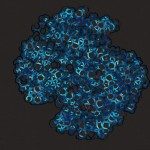Link to Pubmed [PMID] – 25943268
Biomol NMR Assign 2015 May;
The general stress response in Enterobacteria, like Escherichia coli or Salmonella, is controlled by the transcription factor σ(S), encoded by the rpoS gene, which accumulates during stationary phase growth and associates with the core RNA polymerase enzyme (E) to promote transcription of genes involved in cell survival. Tight regulation of σ(S) is essential to preserve the balance between self-preservation under stress conditions and nutritional competence in the absence of stress. Whereas σ factors are generally inactivated upon interaction with anti-sigma proteins, σ(S) binding by the Crl protein facilitates the formation of the holoenzyme Eσ(S), and therefore σ(S)-controlled transcription. Previously, critical residues in both Crl and σ(S) were identified and assigned to the binding interface in the Crl-σ(S) complex. However, high-resolution structural data are missing to fully understand the molecular mechanisms underlying σ(S) activation by Crl, in particular the possible role of Crl in triggering domain rearrangements in the multi-domain protein σ(S). Here we provide the (1)H, (13)C and (15)N resonance assignments of Salmonella enterica serovar Typhimurium Crl, as a starting point for CrlSTM structure determination and further structural investigation of the CrlSTM-σ STM (S) complex.

